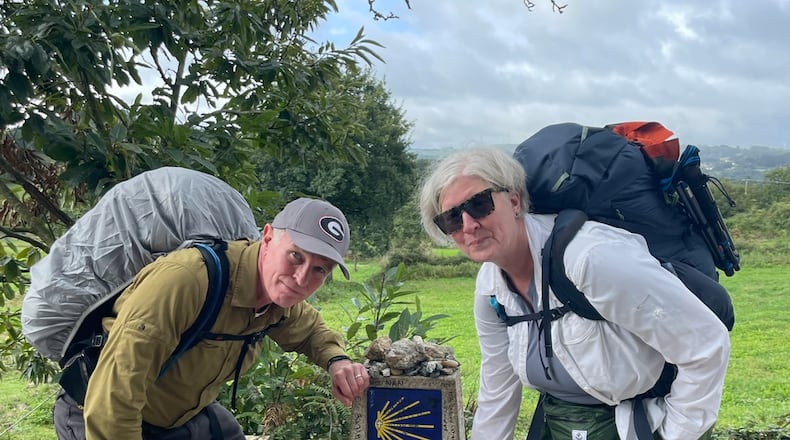While wandering an ancient path in northern Spain I noticed graffiti on a wall: Siempre es hoy.
Translated, it means “It is always today,” which is evident because it is forever true that yesterday is gone and tomorrow has not yet arrived. The author, I suppose, was urging passersby to embrace The Now because it’s all we’ve got.
Those striding El Camino de Santiago are certainly seizing the present, although one can’t help but absorb the past that surrounds you or contemplate the infinity that looms.
El Camino de Santiago (The Way of Saint James) is a medieval route that carries travelers to a majestic cathedral in the city of Santiago de Compostela, where the remains of James, one of the Twelve Apostles, are said to rest.
The millennium-old pilgrimage route is framed by rock fences and tiny hamlets erected by long-forgotten hands. It’s a place where mystical tales are embedded into the stones along the way. It’s history wrapped in mythology, smothered with faith.
The Camino draws the devoted, as well as those seeking a prolonged stroll to clear mind and soul.
Credit: Bill Torpy
Credit: Bill Torpy
My wife, Julie, devised the hike after the death of our youngest child, Michael, in 2019. My newspaper colleagues had presented us with airline vouchers and the idea of tackling this adventure afforded a chance for tranquility, reflection and maybe even some renewal.
The plan was to hit the Camino in April 2020 as temps warmed and the high season had not yet kicked in. Of course, the pandemic intruded on that plan. (Interestingly, another pandemic, the Black Death of the 1300s, helped kill off the pilgrimages until a reawakening in recent decades.)
The Camino has become popular, drawing larger crowds each year. Possibly, “The Way,” a 2011 movie starring Martin Sheen, helped the resurgence. Sheen’s character ends up walking the Camino with his son’s ashes after he was killed on the path. We carried some of our son’s ashes, not as a nod to the movie but because bringing him along is comforting.
Increasingly, many people feel a sense of emptiness in everyday life and want all this to mean something. Donning a backpack and hitting the trail is a way to step outside the norm — literally — and shake things up. It’s a form of therapy, one step after another. And another.
In the past couple years, my right knee deteriorated so much that a one-mile hike, much less a 100-mile jaunt with a backpack, had grown nearly impossible. In March, I got what you’d call a preemptive knee replacement, figuring Julie would head to Spain with or without me. It was an incentive to rehab vigorously or get left behind.
We trained and got path-worthy and then flew off to Spain. Our Catalan friends in Barcelona encouraged us to Vaseline our toes each day to ward off blisters and beware of meigas (witches) along the way. They said that region of Spain — Galicia — is preternaturally eerie. They smiled while recounting this.
Credit: Bill Torpy
Credit: Bill Torpy
Galicia would remind one of Ireland, with its lush fields, ancient rock fences, Celtic DNA and odd affinity for bagpipes and superstition.
We met up with friends Terry and Stephen in a town called Sarria, a 115-kilometer (72-mile) hike from the big cathedral and the minimal distance one must walk to be officially designated as a “pilgrim.” We also planned to then march to the sea but severe blisters on one of the party scotched that idea.
The good part of the hike is you don’t need to carry camping gear because there are many towns and places to stay along the way. That lets you shed 10-15 pounds of gear, allowing a 20-pound pack to be sufficient.
Each day was the same, but different. Every hamlet had a small church or chapel, often with ancient effigies that stare at you. There is something soothing about silently sitting in a 900-year-old shrine, contemplating the centuries.
The week before we flew to Spain, I noticed on Facebook that Tom Rawlings, the former head of Georgia’s Division of Family and Children Services, was walking the Camino. It was his third stint.
“There’s something peaceful and calming about it,” he told me after returning. “I was following in the footsteps of those who have gone long before. You realize that whatever we are dealing with today is fleeting. But some things are eternal.”
Credit: Some random Pilgrim
Credit: Some random Pilgrim
Rawlings is correct about cleansing the mind. I didn’t think of Cop City, Fani Willis or Donald Trump as I trudged along. Instead, I was focused on knocking off the next kilometer as measured by the frequent signs with yellow arrows pointing The Way.
In all, my Fitbit said I walked 196,674 steps that week, about half of which my knee clicked. My surgeon says this is not abnormal.
Slowly, the body submits to the task. The head then follows. One traverses hills, valleys, pastures, more hills and hollows. We met folks from every continent (except Antarctica) and conversation flowed naturally. You might see someone four times that week. Or never again.
The greeting “Buen camino!” rolls off the tongue off-handedly as you pass fellow travelers. There’s a sense of shared purpose, kindness and humanity. I didn’t hear a beeping horn in a week.
It was always today on the path, with a nod to the eternal
About the Author
Keep Reading
The Latest
Featured






